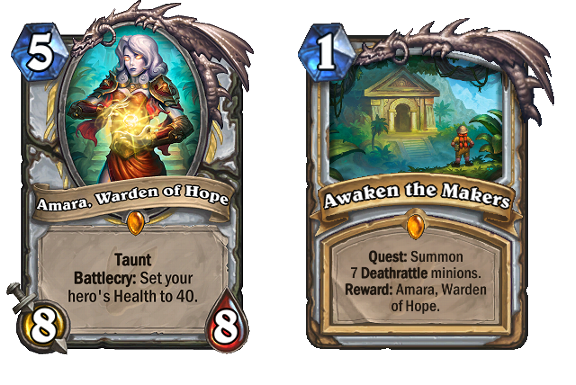Blizzard's Hearthstone has millions of players playing and literally thousands of netdecks (online decklists) available throughout the internet's tubes. Because of this constant activity, the competitive scene has to be constantly fed new content and changes or the strategy space becomes solved and stale.
Blizzard's nerfs to problematic cards Small-Time Buccaneer and Spirit Claws were a much-needed change. Moving eternal deck staples such as Ragnaros, Sylvanas and the trusty Azure Drake to the Wild format forces deckbuilders to find deck-relevant choices rather than "automatic" cards that work well regardless of the situation. The biggest meta change, a Standard rotation that shuffles out the cards of Blackrock Mountain, The Grand Tournament and League of Explorers, is on the horizon. But to get to that point, we need the first expansion set release of the year. And now, we know what it is: a 135-card expansion called Journey to Un'Goro set for an April release.
From the initial cards released, the largest shift you'll notice is two new keywords, Adapt and Quest, the first such addition since Discover became a thing in late 2015 with League of Explorers. Now, it's not true that there have been no mechanic changes, but generally, Blizzard has shied away from making new keywords, essentially making new mechanics with card text rather than a single descriptor. After all, there's no catch-all keyword "Highlander" or "Singleton" for Reno Jackson or Kazakus or Raza the Chained. And the hand buffing and Jade styles of play in Mean Streets of Gadgetzan introduced new mechanics without a new keyword. But this expansion is different.
Quest is probably the mechanic that's most innovative in the context of Hearthstone, almost like a turbocharged Secret. Like Secrets in Hearthstone, Quests are cards that don't do anything at the moment they're played; they're effects that activate after you fulfill a set of conditions. The first Quest card shown by Blizzard, Awaken the Makers, is a Quest that, if successful, will award you the card Amara, Warden of Hope. Amara is a five-mana 8/8 (cue the four-mana 7/7 memes!) that is both a Taunt and sets your hero's Health (Priests only) to 40. In this case, you only get the card after summoning seven Deathrattle minions.

Your legendary Quest card is also guaranteed to be in your opening hand, meaning that you don't have to hope to draw it at some point and you can start working on the requirements immediately. This differs from a card like Elise Starseeker which can change all of your cards to legendaries, but you have to draw her before you can play her and unlock the requirements for this effect, namely, drawing other special cards.
One of the nice things about Quest is that if all the Quests are designed in this manner, it's a powerful effect that gives a valuable tool to a player playing a more Control-style deck without giving them a card that an aggro deck can use for its own purposes.
The second keyword introduced is Adapt, which works like a mashup of Discover, which is Druid's Choose One effect, and the spare parts that we saw a lot of during the Goblins vs. Gnomes era.
With an Adapt minion, once you play the minion or an effect that triggers Adapt, you get to discover a modification that changes something about the minion, a bit like the spare parts I referenced above (one-mana cards you had to collect and play). Adapt options include adding Divine Shield, +3 Attack, Windfury, Taunt, a token-summoning Deathrattle or the inability to be targeted by magic spells.
Blizzard demonstrates Adapt with Verdant Longneck, a five-mana 5/4 Beast for Druid. 5/4 is a typical generic statline for a four-mana card, most comparatively the four-mana 5/4 Lost Tallstrider, a Beast card from Goblins vs. Gnomes that rotated out last year. Obviously, without the Adapt mechanic, this would be a below-average card, i.e. a worse Booty Bay Bodyguard, but you can choose the additional effect best suited to the board state. Since this is a situational card, sometimes you'll actually want the Booty Bay Bodyguard or an 8/4 five-mana card, or a 5/4 with Windfury. To see the value of this kind of thing, look at Druid of the Claw: a 4/6 Taunt or a 4/4 with Charge are not overwhelmingly great choices by themselves, but the fact that you can choose which one you want at the given moment makes the card worth more than the sum of its parts.

Also shown off was Pyros, a Mage legendary card with a design that resembles a phoenix. It starts off as a two-mana 2/2 and when it dies, you get a six-mana 6/6, and when that dies, you get a ten-mana 10/10. While the stats themselves are underpowered, a 6/6 for six isn't so bad when you can draw it for free and you don't have to actually play it in your deck. Of significance but not really talked about by Blizzard is that Pyros comes with a new Tribal name, Elemental. The consequences of that feature are firmly in the To Be Determined category, but it's something to pay attention to and may come into play in future expansions, if not this one.
The last card revealed was Volcano, a Shaman spell that deals 15 damage randomly split among all minions, for five mana and two overload. What's very important to note is this spell does not do damage to the enemy hero, so it won't empower the Aggro Shaman-type decks; it's more for the reactive Shaman decks like Control Shaman, which very much needs a replacement for Elemental Destruction, one of the cards that's rotating out with Un'Goro's release.
Journey to Un'Goro is scheduled to hit the virtual shelves sometime in April, with preorders available Tuesday with the usual rewards (pack discount, card back).

